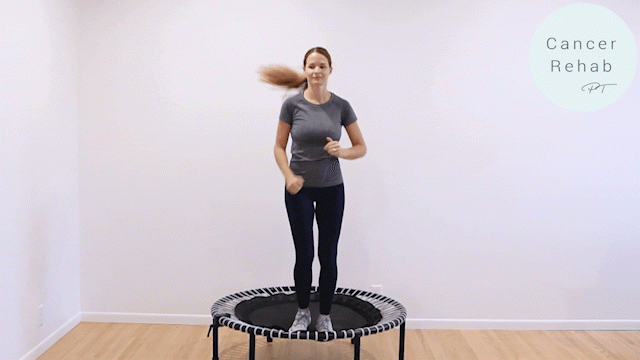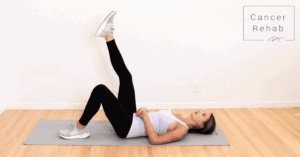Your lymphatic system helps keep your body healthy by removing toxins and waste. A rebounder workout is one of the best ways to support it and keep the fluid circulating in your body.
I’m a Physical Therapist who specializes in the lymphatic system as well as oncology. In this blog post, I’m sharing a full-body trampoline workout to get your lymphatic system and blood pumping!
Before you start any new exercise routine, check with your doctor to make sure it’s right for you.
What Is a Rebounder Workout?
A rebounder is a small, special exercise trampoline.
It’s different from the big trampolines you might see in backyards. Rebounders are made for fitness, not for high jumps or tricks. You can use them for gentle bouncing or more energetic exercises.
Trampoline workouts are perfect for all fitness levels – whether you’re just starting out or you’re already quite active.
As a Doctor of Physical Therapy, I believe that trampoline exercises aren’t only a great cardio workout but also beneficial for your lymphatic system.
Rebounder Workout Benefits
Rebounding is especially good for your lymphatic system.
When you bounce, you create a pumping effect in your body that helps move lymphatic fluid. This movement helps clean out your system naturally.
It’s also easier on your joints than exercising on hard surfaces. The trampoline’s unstable surface absorbs most of the impact when you land.
Here’s what a rebounding workout can do for you:
- Help your lymphatic system remove toxins from your body
- Support healthy lymph fluid movement throughout your system
- Boost your immune system through better lymph flow
- Help keep your bones strong through gentle impact
- Improve your heart health
- Build stronger muscles
- Help you balance better
- Give your lungs a good workout
- Be gentle on your joints and ligaments
- Help reduce stress
If you live with a chronic condition like lymphedema, a rebounder workout is a great addition to your self-management routine. All you need is a rebounder trampoline and 10-30 minutes of your time for an effective workout!
You can also find more support in my programs Lower Body Lymphedema Rehab and Breast Cancer Rehab or Digital Exercise Guides.
10-Minute Rebounder Workout: 15 Exercises from a Physical Therapist
Here’s a workout you can do on a small trampoline for a healthier lymphatic system and muscle strength.
You can follow along with my YouTube video! This full-body rebounder workout should take you about 10 minutes.
1. Walk in Place

Start by simply walking on your rebounder. Stand tall with your feet shoulder width and your core engaged. This gentle movement helps you find your balance and gets your lymphatic system working.
2. Larger Marching with Arm Swings

Lift your knees a bit higher now. Let your arms swing naturally like you’re taking a brisk walk. This movement gets more of your body involved and helps pump lymphatic fluid through your system.
3. Weight Shift Jumps

Stand with your feet hip-width apart with a slight bend. Gently shift your weight from one foot to the other while bouncing from side to side. This helps move lymph fluid in your legs and improve balance. It gets your heart pumping, too!
4. Jumping Jacks with Feet

Move your feet out and in, like you’re doing the bottom half of a jumping jack. This helps you stay stable while working your lower body. You don’t have to move your arms for this exercise (you can keep your arms straight or bent, whatever you prefer).
5. Jumping Jacks with Arms

Now add your arms to the movement. Reach out to the sides and up over your head while your feet move. This gets your whole body moving and helps lymph flow everywhere.
6. Split Jumps with Arms by Sides

Step one foot forward and one foot back while keeping your knees slightly bent. Switch them back and forth with a gentle bounce. This helps your balance and gets the lymph moving in your legs. Make sure to maintain proper form and switch legs as fast as it’s comfortable for you.
7. Split Jumps with Biceps Curls

Keep switching your feet front to back. Now add arm curls – bring your hands up toward your shoulders as you jump. This adds upper body movement to help lymph flow in your arms.
8. Large Run

Run in place with slightly higher bounces. Keep your movements controlled. This exercise really gets your entire body pumping!
9. Cross Overs

Step side to side, crossing your left leg over your right leg and the other way around. Do the same thing with your arms. Do a basic bounce as you move. This exercise helps your coordination and moves lymph in different directions.
10. Rotation Jumps

Make small jumps while slowly turning your body. Start slow and stay in control of your movement.
11. Monster Jumps

Take wider steps while bouncing, like a big jumping jack. Focus on your lower body movement.
12. Monster Jumps with Arm Openers

Add big arm movements to your monster jumps. Open and close your arms with your legs. This helps lymph flow through your whole body.
13. Opposite Hand to Knee Taps

While bouncing, touch your right hand to your left knee, then switch sides. Keep your core engaged.
14. Side Crunches

Bounce on the mini trampoline while bending to each side. Reach toward your outer thigh. This helps move lymph fluid in your core and sides.
15. Heel Taps

Tap your heels out in front of you, one at a time. Keep bouncing gently. This is a good cool-down rebounder exercise!
Beginner Rebounder Workout
If you’re new to rebounding, take it slow.
Start with basic walking and gentle bouncing. Focus on keeping your balance. You might want to begin with just 5-10 minutes. You can do more as you get comfortable with the movement. It’s better to start slow and stay safe.
Any movement, even for just a few minutes per day, is beneficial to your lymphatic system. So don’t try to do too much too fast.
How Many Minutes a Day Should You Rebound?
Start with 5-10 minutes a day, or whatever feels right for you. You can slowly add more time as your body gets used to it. Some people work up to 20-30 minutes per session. The most important thing is to listen to your body and be consistent.
What Is the Best Trampoline for a Rebounder Workout?
I use a Bellicon 44″ Trampoline, but it’s on the more expensive side. That said, there are good options for every budget.
The BCAN 40″ Foldable Mini Trampoline with Handle is great – it holds up to 330 pounds and has a handle for extra support. The Darchen Mini Trampoline is another good choice that supports up to 450 pounds.
Please note that these links are affiliate links. If you purchase a product or service using these links, I may receive a small commission. There is no additional charge to you, and I only recommend products I know, use, and love!
FAQs
Does Rebounding Exercise Really Work?
Yes, rebounding is a proven form of exercise that offers real benefits for your body. Studies have shown that bouncing on a mini trampoline is 68% more efficient than running because it expends less energy and places less stress on the cardiovascular system and joints. Rebounding workouts also help move lymph fluid through your system.
Regular rebounding can improve your balance, strengthen your muscles, boost your cardiovascular health, and even help maintain bone density. Many people report feeling more energized and noticing improvements in their overall health and fitness level after adding rebounding to their routine.
Is Rebounding Good for Losing Weight?
Regular rebounder workouts can be a great tool for weight management. Rebounding helps you burn calories while being much gentler on your joints than running or high-impact exercises. Many people also find rebounding to be more enjoyable than traditional cardio exercises, which means they’re more likely to stick with it as part of their regular routine.
Should You Wear Shoes on a Rebounder?
You can rebound either barefoot or wearing shoes – both options have their benefits. If you choose to wear shoes, pick ones with good support and avoid thick soles that might make it harder to feel the trampoline surface. If you prefer going barefoot, this can help you better feel the trampoline surface and improve your balance. Some people find that rebounding barefoot gives them a better connection to their movement. Ultimately, it’s about your personal preference and comfort.
Is Rebounding Better Than Walking?
Both rebounding and walking are great forms of exercise. Rebounding has a special advantage when it comes to lymphatic health because of the up-and-down motion. This motion creates a pumping effect that helps move lymph fluid through your body more effectively. At the same time, walking is great for getting outside and covering distance. You can combine both activities, but rebounding can give you a more intensive workout in less time!
Can I Just Jump on a Rebounder?
Simple bouncing provides some benefits, but following a structured rebounder workout will give you better results. You can start with basic bounces to get comfortable on the rebounder. But once you’re familiar with the mini-trampoline, adding different movements will work more muscle groups and have more benefits for your lymphatic system.
What Are the Cons of Rebounding?
Like any form of exercise, rebounding isn’t perfect for everyone. Some people might feel dizzy when they first start, especially if they have inner ear issues or balance problems. Some people might also need to avoid rebounding due to certain health conditions like severe back problems or recent surgery.
You also need enough ceiling height to bounce comfortably, and you should always check your rebounder for wear and tear. Always check with your healthcare provider before starting any new exercise routine.
How Long Should I Rebound for Lymphatic Drainage?
You should aim to rebound for at least 10-15 minutes each session. This gives your body enough time to create the pumping effect that helps move lymph fluid. You don’t need to bounce vigorously – gentle, consistent movement works well for lymphatic health. You can also do two or three shorter sessions throughout the day rather than one longer session. But ultimately, even a few minutes of gentle bouncing several times a day can help support your lymphatic health!
Is Rebounding Good for Over 50?
Rebounding can be a great exercise choice for many people over 50. It’s low impact, which makes it easier on your joints compared to activities like running or jumping on hard surfaces. Regular rebounding can help maintain bone density, improve muscle strength, and support lymphatic and cardiovascular health. It’s also great for improving balance, which becomes increasingly important as we age. You can get a rebounder trampoline with a stability bar for extra security.
Get More Lymphatic Drainage Support
Regular rebounding exercise is a great way to support your lymphatic system. Start slowly, maintain consistency, and listen to your body’s signals.
I have a rebounder workout playlist for lymphatic drainage on YouTube. You can also find more lymphatic system support in my programs Lower Body Lymphedema Rehab and Breast Cancer Rehab or Digital Exercise Guides.











